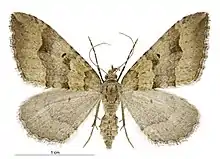Epyaxa rosearia
Epyaxa rosearia, the New Zealand looper or plantain moth,[1][2] is a moth of the family Geometridae. It is endemic to New Zealand.
| New Zealand looper | |
|---|---|
 | |
| Female | |
 | |
| Male | |
| Scientific classification | |
| Kingdom: | |
| Phylum: | |
| Class: | |
| Order: | |
| Family: | |
| Genus: | |
| Species: | E. rosearia |
| Binomial name | |
| Epyaxa rosearia (Doubleday, 1843) | |
| Synonyms | |
| |
Taxonomy
E. rosearia was first described by Edward Doubleday in 1843 and named Cidaria rosearia.[3][4]
Description
The eggs of this species are pale yellow and oval with a smooth shell.[5]
Alex Purdie describes the caterpillar of this species as:
Length, at rest, about three- quarters of an inch. Colour light-green, with indistinct whitish longitudinal lines, and a narrow median dorsal stripe of the ground colour, edged on each side by one of these whitish lines; a subdorsal whitish line on each side of the median stripe; the ground colour shows again as a lateral line, edged below with whitish. Under-side with delicate whitish or yellowish longitudinal tracings, as on the upper side. The junctions of the segments show yellowish or whitish rings when the larva contracts. Head, greenish-yellow. Body tapering somewhat to the head.[5]
The caterpillars form a chrysalis that is glossy and very dark brownish black.[5] They can be found amongst the leaves of the forest floor.[6] E. rosearia adults are varied in appearance. They can have a pinkish tinge or can be brownish in hue although olive green is also common.[6]
Distribution
E. rosearia are very common throughout New Zealand.[6]
Host species
While it is endemic to New Zealand,[7] the larvae have so far only been recorded feeding on exotic plant species: Nasturtium officinale, Plantago lanceolata, Trifolium ambiguum, Trifolium repens and Tropaeolum majus.[8] The larvae also seem to feed on the leaves of Trifolium caucasicum.
References
| Wikimedia Commons has media related to Epyaxa rosearia. |
- Edlin, Bob (20 April 2014). "North Island farmers report bumper summer for native plantain moth". AgScience. New Zealand Institute of Agricultural and Horticultural Science. Retrieved 14 May 2019.
- "Plantain moth". AgPest. AgResearch. Retrieved 14 May 2019.
- "Cidaria rosearia Doubleday, 1843". New Zealand Organisms Register. Landcare Research New Zealand Ltd. Retrieved 15 January 2018.
- Dieffenbach, E. (1843). "List of Annulose Animals hitherto recorded as found in New Zealand with descriptions of some new species by Messrs. Adam White and Edward Doubleday". Travels in New Zealand: With Contributions to the Geography, Geology, Botany and Natural History of the Country. 2. London: John Murray. p. 285.
- Purdie, A. (1885). "Life History of Epyaxa rosearia, Dbld". Transactions and Proceedings of the New Zealand Institute. 18: 208–209 – via Biodiversity Heritage Library.
- Hoare, Robert J. B. (2014). A Photographic Guide to Moths & Butterflies of New Zealand. Ball, Olivier. Auckland: New Holland Publishers (NZ) Ltd. p. 95. ISBN 9781869663995. OCLC 891672034.
- "Epyaxa rosearia (Doubleday, 1843)". New Zealand Organisms Register. Landcare Research New Zealand Ltd. Retrieved 14 January 2018.
- "PlantSynz - Invertebrate herbivore biodiversity assessment tool: Database". Plant-SyNZ. Landcare Research New Zealand Ltd. 2011. Retrieved 14 January 2018.